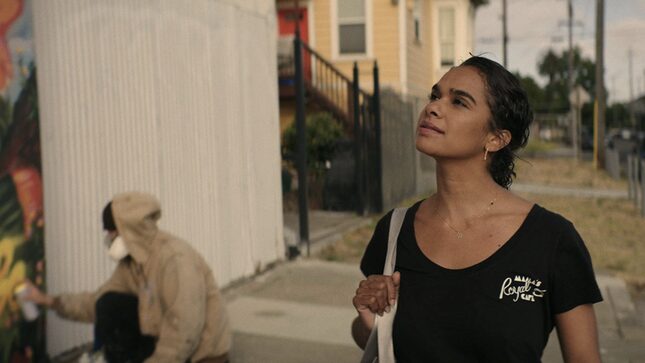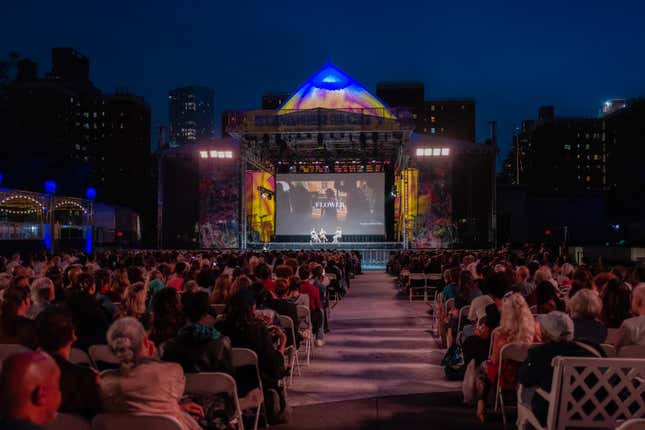Misty Copeland on Playing a Woman About to Be Unhoused and Dancing While ‘Very Pregnant’
She spoke to Jezebel about her new short film Flower, returning to dance, and ballet's "bubble of elitism."
In Depth

There’s a scene in Misty Copeland’s new short film Flower that remains lodged in my chest. Having just received an eviction notice, Rose, the character played by the American Ballet Theatre principal dancer, settles down into an armchair in the corner of her living room. Rose had picked up several jobs over the years as her mother Gloria’s dementia worsened, waiting tables and teaching children’s ballet classes to cover piling medical bills. Exhaustion now sweeps over Rose. She slips her headphones on. One more song, and then she’ll deal with reality. She drifts to sleep, fading into the armchair.
Then, Gloria (played by former Dance Theatre of Harlem and Complexions Contemporary Ballet dancer Christina Johnson) is in the doorway, her face animated as she extends a hand to her daughter, inviting her to dance. Startled, Rose hesitates. Her mother—the woman who had folded into herself, all her edges blurred—is in front of her like a ghost. Then she smiles, rises to meet Gloria, and they take off into a familiar sequence, as though mother and daughter have danced these steps in lifetimes outside of this one, swept into the rhythm. Tenderness in motion, they spin and laugh and—Rose jolts awake. The eviction notice weighs heavy in her lap.
This moment from the 28-minute film, produced by Copeland and Leyla Fayyaz’ company Life in Motion, shows the ease with which everyday people can slip into housing instability. Using the wreckage of Rose and Gloria’s home lives as its narrative vehicle, Flower surveys the destruction in Oakland, California, caused by the Bay Area’s housing crisis and intensified by the pandemic. Melding balletic choreography by Alonzo King, founder and artistic director of Alonzo King LINES Ballet in San Francisco, with music composed by Grammy Award-winning artist Raphael Saadiq, it also calls upon Black silent films of the ‘20s to portray the emotions of a community in crisis. And without dialogue, its most breathtaking displays of humanity happen on the faces and bodies of its artists.
On Friday, Copeland spoke to Jezebel ahead of a public screening of Flower at the Lincoln Center after its debut at the Tribeca Film Festival. We know Misty Copeland the dancer, who in 2014 became the first Black woman to perform the lead role of Odette/Odile in ABT’s Swan Lake, and in 2015 became the first Black principal dancer in the company’s history. Here, we meet Misty the humanitarian, the auteur, the mother. After three years away from the stage and the birth of her son Jackson, she’s returned to ballet in rare form: raw, nerve endings exposed.
The following conversation has been edited for clarity.
JEZEBEL: Considering the sheer amount of content produced around the housing crisis that relies on tired tropes, the empathetic manner in which you’ve approached this issue feels significant. In Flower, the three unhoused individuals your character speaks to are the only actual voices heard in the film. Can you tell me about that choice?
MISTY COPELAND: We went back and forth with our director Lauren Finerman on this. We wanted to show the community, but we wanted to be respectful. Would they be comfortable on screen? What were those boundaries that we didn’t want to be disrespectful of or cross? Because the film is not a documentary: It’s actors dancing and telling the story. We briefly discussed having dancers or actors portraying the unhoused, and we decided that’s something we wanted to stay away from. The question then became, how do we really capture them and their voices in a real way?
“I grew up houseless for a lot of my childhood and know what that feels like to not have stability, to not have real structure in your life, and to not know what tomorrow might look like.”
So we went in secure and planned and intentional, and had an honest conversation with members of the community. We asked, “What has your life experience been? How did you end up here?” And we just let them talk. We had no idea what we were going to do with the footage. We had discussed having them on screen, but not hearing their voices and possibly having their voices play over the credits at the end. But then we decided to just see what it felt like when we hear them and see them in the middle of this film. And it felt so right. It’s this juxtaposition of showing the power of storytelling without using your voice, but then, we needed to hear their voices and see their faces, because the houseless look so different from the stereotypes people draw on. The character that I portray, for example, is right on the edge of losing her childhood home and working two jobs and taking care of a mother with dementia.
What was it like for you to inhabit that character? I know you also experienced housing instability throughout your childhood.
-

-

-

-

-

-

-

-

-

-

-

-

-

-

-

-

-

-

-

-

-

-

-

-

-

-

-

-

-

-

-

-

-

-

-

-

-

-

-

-










































